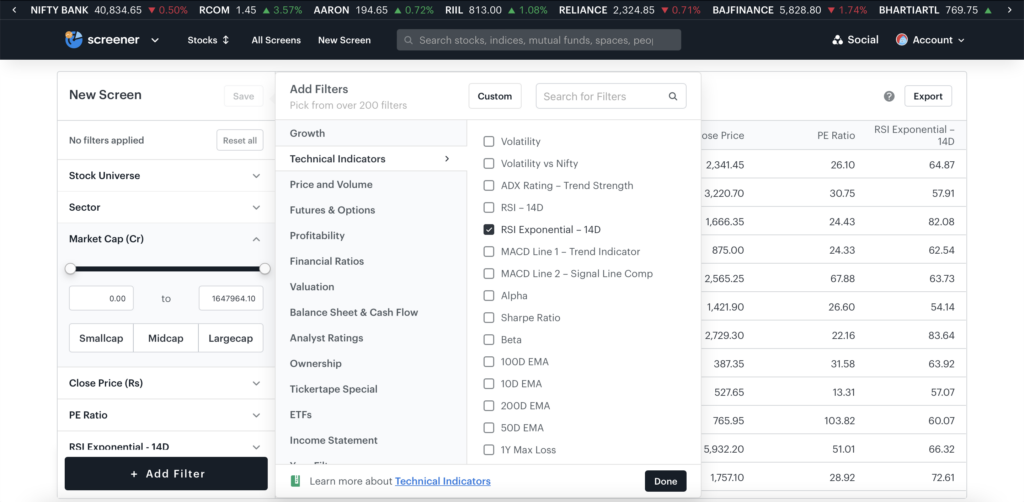Securities trading is a practice in which participants in financial markets aim to profit from changes in the prices of securities. Traders use various kinds of trading strategies to identify trends and patterns in price movements and attempt to make profits.
There are numerous trading strategies available to a trader; swing trading is one of them. Let us understand it in detail.

What is swing trading in the stock market?
Swing trading is a trading strategy that involves investors purchasing stocks or other financial instruments and holding them for a relatively short period (i.e. a few days to several weeks) in the hope of making a profit from their price fluctuations.
Swing traders in the stock market aim to make short- to medium-term gains on a stock over a few days to several weeks.
Swing trading is based on the notion that when a security’s price has increased or decreased to a certain point, it may be ready for a reversal. Swing traders use technical analysis to determine entry points and exit points.
Swing Trading – Points to Note!
- Swing trading entails entering positions for periods ranging from a few days to weeks to capitalise on price movements. Choosing appropriate security is crucial in swing trading.
- Swing trading aims to profit from price fluctuations. Traders use various fundamental and technical analysis techniques to determine the right entry and exit points.
- Swing traders use technical indicators like MACD, Fibonacci retracements, moving averages etc.
- Volatility and liquidity are two important criteria to be considered when selecting a stock for swing trading.
What is the objective of swing trading?
Capturing a portion of a potential change in price is the main aim of swing trading. In other words, the purpose of swing trading is to capitalise on price movements.
Different swing traders can have different trading mindsets and approaches. While some traders enjoy working with stocks with a lot of movement and volatility, others might favour more steady stocks.
How does swing trading work?
The ability to read a price chart and the ability to analyse patterns in price charts make up the basis of swing trading.
Follow the instructions below to begin swing trading:
- Start by picking the “right” stock. There are various ways to do so, including market analysis, technical analysis, and fundamental analysis.
- Proceed to analyse the chart of the selected stock. Use indicators like Relative Strength Index (RSI), volume, Moving Average Convergence Divergence (MACD), trend lines, etc., to draw conclusions about likely price movements.
After analysing the relevant stock thoroughly, you can decide your entry and exit points and strategy.
Day trading vs swing trading
Day trading is when traders buy and sell a given stock or other financial instruments within a single trading day. In contrast, swing traders aim to profit from price changes over more extended periods, typically several days to weeks.

The key differences between these two types of trading are:
| Day trading | Swing trading |
| When traders buy and sell securities within a single trading day, it is referred to as day trading. | Buying and selling securities over a somewhat longer period of time (a few days to a few weeks) is referred to as swing trading. |
| Day trading typically involves a higher number of daily transactions. | Swing trading typically involves a much lower number of daily transactions. |
| In day trading, margin requirements are lower. | In swing trading, margin requirements are higher. |
Example of stock swing trading
For instance, suppose a trader buys 5,000 shares of company XYZ, trading at Rs. 100 with a total investment of Rs. 5,00,000. The trader believes the price will rise and enters the market with a swing trading mindset. After some days, the share price is Rs. 150. The trader sells the entire position valued at Rs. 7,50,000. Hence, by utilising this strategy and with a price rise of 50 points, the trader makes a profit of Rs. 1,50,000.
Swing trading strategies
A few of the most popular swing trading strategies are:
- Fibonacci retracements
Using the Fibonacci Retracement technical indicator, traders can gauge the support and resistance levels for a given security.
- Trading channels
A trading channel is a channel visualised on the price chart of a security by drawing two straight lines that connect multiple support levels and resistance levels, respectively. Traders might often consider a price to remain confined to a channel until a certain critical support or resistance level is reached.
- 10- and 20-day SMA
A simple moving average is created by averaging a security’s price over a specific period. It can give you a range of an asset’s price movement over a period of 10/20 days.
- MACD (Moving Average Convergence Divergence) crossover
It can be used to gauge whether the new trend is bearish or bullish. The same information can be used to study stock movements.
You can use Tickertape Stock Screener to filter the stocks based on technical indicators like MACD, RSI, volatility, and more.

Finding stocks to swing trade
Finding the right stock in swing trading is crucial to maximising profits. Traders should consider two factors when making a trade.
- Volatility
- Liquidity
Volatility in the stock is essential to profit from the trade. If there is no volatility, profit opportunities will be minimal. Liquidity is also equally important for the easy buy and sell of shares and securities.
The right market for swing trading
Swing trading can be successfully carried out in all kinds of markets. In addition to buying a security at a low price and selling it at a higher price, swing traders can also short-sell securities at a high price and then buy them back at a lower price. Thus, swing trading can be profitable in bull as well as bear markets.
In addition, financial markets that are moving sideways also offer excellent swing trading circumstances. The best swing trading opportunities arise when the market is changing from a bear market to a bull market or when the market is experiencing significant uncertainty.
Using the exponential moving average
An alternative to the SMA that emphasises the most recent data points is the EMA. The EMA offers traders entry and exit opportunities and unique trend signals. Swing traders can attempt to time entry and exit points using the EMA crossover.
How much profit can I expect from swing trading?
The earnings potential of traders is unbounded. However, they need to do some research first before making any decisions.
Is swing trading risky?
Compared to day trading, swing trading carries the risk incurred by holding a position overnight and over weekends. However, in contrast, the risk of being forced to take a loss due to the end of the trading day is absent.
Conclusion
One of the most common trading strategies is swing trading. This involves buying and selling securities within a few days or a few weeks’ time. However, not all securities can be selected for swing trading. Traders use a number of technical tools and strategies to swing trade. Remember that swing trading is not the same as intraday trading.



